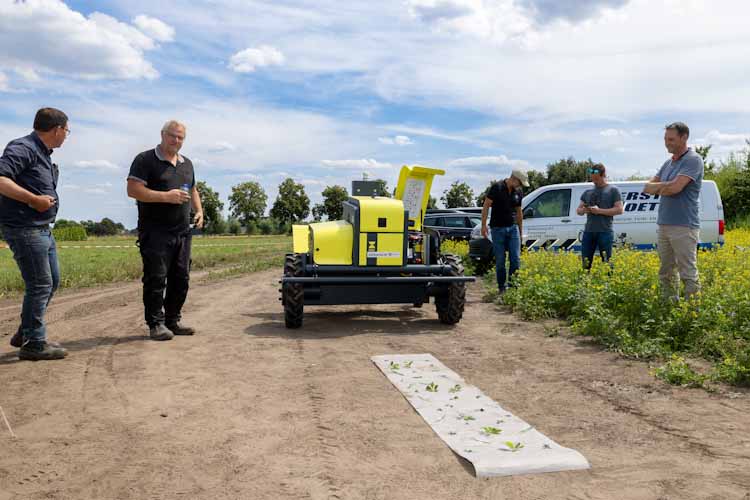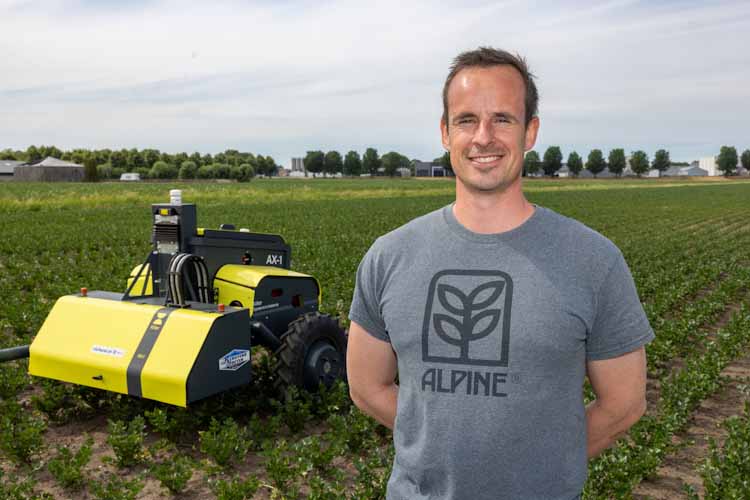Norwegian Kilter AX-1 robot sprays with high precision

The Kilter AX-1 robot spot-sprayer is a unique herbicide droplet generator, which targets weeds with high precision. According to the Norwegian manufacturer Kilter Systems, the AX-1 technology can reduce herbicide use by up to 95%. It can also increase yield by 35%. The technology also ensures a more uniform crop quality. In the Netherlands, the Kilter is still awaiting a ‘drift label’.
Kilter Systems is a technology company in Norway that helps vegetable growers tackle challenges in weed control. Conventional weed control is often expensive, time-consuming, and can be harmful to both crop and environment. To prevent crop damage, manual weeding is often still necessary. This is not only increasingly expensive, but manual labour is also hard to find. The decreasing range of available herbicides also demands alternative solutions. Kilter Systems found its answer in the development of the AX-1. This is a self-propelled robot with so-called ‘single drop technology’. Using artificial intelligence (AI), the AX-1 detects weeds in a range of crops, for which specific recognition models have been developed. The robot then applies herbicide droplets directly to the detected weeds. Weeds are recognised using camera modules with an integrated droplet generator. Each module covers 25 centimetres and contains 42 controlled nozzles that administer the herbicide.
‘Matrix printer’
“The spray pattern looks like small dots in a row, similar to a matrix printer,” says Jesper Voois, representative for Kilter Systems in the Netherlands. “The droplets are released in a 6×6 millimetre pattern with minimal drift. This technique ensures that only the weed is targeted. The chance of a droplet hitting the crop plant is very small. Some German growers with more experience using the Kilter employ non-selective products with minimal side effects for the crop.” The Kilter AX-1 was originally developed and designed for vegetable cultivation in flat beds. “Currently, the robot is used in carrots, parsnips, onions, red beet, lamb’s lettuce, parsley, spinach, rocket, and celeriac. Chicory is the first arable crop where the Kilter AX-1 is operating,” says Voois. “We are continuously expanding the number of crops the AX-1 can handle. In these intensive crops, investment in the Kilter robot is quickly recouped thanks to significant savings on manual labour and improved crop quality, by avoiding phytotoxic stress.”
Kilter in short
The autonomous precision applicator is the result of the AsteriX project, developed by Adigo AS and spun off into Kilter AS. Kilter means ‘in balance’ and refers to the imbalance that exists between the environment and global food production. For over 15 years, Kilter Systems has developed technology aimed at restoring the necessary balance in sustainable agriculture. The result, the AX-1, is the world’s first agricultural robot to use Deep Learning Neural Networks in combination with leading nozzle technology. Kilter is supported by, among others, Innovasjon Norge, the EU Horizon2020 programme, and the Research Council. Track width: 1.55 to 2 metres, weight: 260 kg. Drive: electric drive powered by Honda petrol generator. Working width: 1.32 to 1.58 metres. Working speed: 1.1 to 2.5 km per hour. Capacity: 5 to 7 hectares per day. Purchase price: around €120,000 (excluding VAT) and a maintenance package.
Saves a lot of money
The robot has a 52-litre herbicide tank. Thanks to highly precise dosing of this 52 litres, the AX-1 has, according to the Norwegian supplier, a capacity comparable to a broadcast application of 2,000 litres of herbicide. “A saving of up to 95% on herbicides, which makes a big financial difference. The soil and crop plants are exposed as little as possible to the selective products. This leads to improved quality and uniformity, and potentially higher yields from the harvested crops.” In Norway, Sweden, Denmark, and Germany, the AX-1 has been operating for 2 years on fifteen vegetable farms. “In those countries, they apply pelargonic acid, a biological burn-down agent,” says Voois. “Just a few drops of pelargonic acid ensure that the small weeds die off, while the useful plants can continue to develop undisturbed.” Unlike conventional herbicides, pelargonic acid breaks down within a few days in the crop. In the Netherlands, growers can use glyphosate or another herbicide to kill the weeds.

Very well received
“For several growers who have worked with the AX-1 for some time, the field performance has been so positive that they have purchased a second or even third robot,” says Voois. “In the Netherlands, we tested the AX-1 in chicory in cooperation with Sensus, and at a second commercial farm we are investigating how the robot operates in vegetables.” Kilter Systems wants to sell the robot in the Netherlands from 2026, but for now, it depends on obtaining the correct drift label. “Normally, this is handled via certification of the spray nozzles on a sprayer. But the AX-1 has nozzles that release droplets, and current regulations do not cover this,” says Voois. “It is not a conventional sprayer, so the AX-1 must be tested for drift. We will do this later this year at Wageningen University & Research. We are now working on setting up a distribution network for the AX-1 in the Netherlands and other parts of Europe.”




